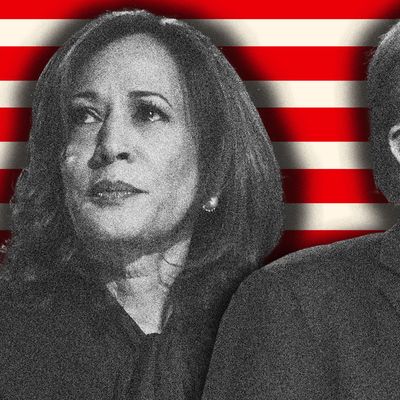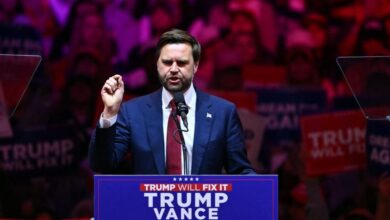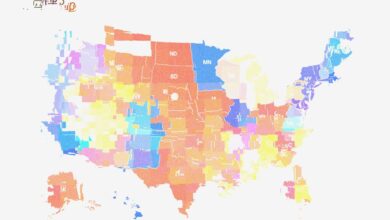

Photo-Illustration: Intelligencer; Photos: Getty Images
Back in the day, presidential general elections began in earnest after Labor Day, when kids were back in school, summer vacations were a fleeting memory, and voters finally focused on the fateful decision they would make in November.
Nowadays, presidential campaigns are grinding, multiyear exercises, and the general-election cycle begins the moment the field is set. The 2024 election cycle actually began in the spring of 2020, when it became clear the race would be a rematch between Joe Biden and Donald Trump. But then with Biden’s withdrawal on July 21, 2024, everything changed, and the axiom “Nothing happens in August” died for good.
The new Harris–Trump contest a sprint, not a marathon. And with both candidates freshly nominated, it’s time for a reset of what we can expect between now and November 5.
It’s basically a dead heat at this point with a slight advantage to the Harris-Walz ticket, potentially offset by an Electoral College advantage for Trump-Vance. Democratic gains that began almost instantly when Biden handed the nomination to Harris have persisted long enough that it’s impossible to see them as a bounce or a blip; she has eliminated the national polling lead Trump held for much of 2024 and is in a competitive position in all seven battleground states (Arizona, Georgia, Michigan, Nevada, North Carolina, Pennsylvania, and Wisconsin).
Demographically, Harris has brought back a lot of young and Black voters who were blah about Biden, with less striking but significant gains among Latinos as well. Most important, Democratic enthusiasm matches Republican enthusiasm. And more generally, gains in favorability by the two presidential candidates (in Trump’s case, emerging after the assassination attempt) have improved prospects for strong general-election turnout while greatly decreasing the number of voters who dislike both of them. Perhaps as a by-product of this trend, the standing of non-major-party candidates has declined dramatically, marked by a collapse in support for Robert F. Kennedy Jr. followed by his withdrawal from the race and endorsement of Trump.
Harris’s gains in the Sun Belt battleground states (where Biden seemed hopelessly behind) have opened up multiple paths to 270 electoral voters for her beyond the “blue wall” of Michigan, Pennsylvania, and Wisconsin on which Biden totally depended, giving her significantly better strategic flexibility. And the enormous boost in donations after the Biden-Harris switch has brought her at least into parity with Trump, eliminating what had looked like a big Trump advantage in cash on hand and key-state advertising in the final stretch.
Assuming last-minute disputes over mic muting are resolved, it’s very likely Harris and Trump will debate at least once, in an ABC-sponsored encounter on September 10. After that, they may debate a second time on NBC, and there will definitely be a Vance-Walz vice-presidential debate on October 1 sponsored by CBS. But the first presidential debate (typically, the one that draws the most viewership and attention) is the one that could matter most. For one thing, it’s the first debate Harris has participated in since October 2020 when she faced off with then-VP Mike Pence. For another, it will test each campaign’s message and strategy for the rest of the season. Beyond that, voters will actually begin early voting in four battleground states (in chronological order, North Carolina, Pennsylvania, Wisconsin, and Michigan) in September.
Given what happened to Biden on June 27, both candidates may face increased scrutiny of their attentiveness, responsiveness, and coherence. It’s a competition the ever-rambling word-salad chef Trump is not likely to win, but nobody is better than the 45th president at hammering in negative characterizations of an opponent — though it’s anyone’s guess as to whether his handlers can reduce his reliance on nasty nicknames and pointless insults that don’t reinforce what he needs to say.
As the Democratic National Convention showed, the Harris-Walz campaign is reasonably confident about maintaining the greatly revived enthusiasm of Democrats without any overt base tending (beyond the usual get-out-the-vote efforts and upbeat candidate appearances). Messaging can thus be directed at persuading independents and swing voters, as her acceptance speech in Chicago sought to do. Some of that persuasion program is proactive, giving undecided voters reason to feel good about the agenda of a Harris administration. Much of it is preemptive, countering the inevitable attacks on her by the opposition as both responsible for Biden’s alleged failures and captive to a “radical leftist” ideology. And a lot of it will be negative, aimed at increasing the already sizable number of voters who would prefer almost anyone to Trump.
As a relatively little-known candidate, Harris needs to define herself even as she leans into her opponent’s established depiction as a dangerous extremist with contempt for the Constitution and for freedom itself.
There are three basic ways to deal with a political landscape in which you are associated with a strongly unpopular status quo: (1) change perceptions of that status quo to improve its popularity (a very hard thing to do, as pundits learned when they tried to convince Americans the Biden economy is actually quite good); (2) refocus voters on the equally unpopular record of your opponent (which the Biden campaign sought to do with its reminders of January 6 and Trump’s criminal indictments); or (3) make the contest a choice between two future agendas, one sensible sounding and one extremist. It’s pretty clear the Harris campaign has chosen the message behind door No. 3.
In this, Harris is helped immensely by the sense that, while she has spent nearly four years as a loyal member of the Biden administration, she represents a fresh start for Democrats and potentially for the country. We’re also beginning to understand retroactively that Biden’s unpopularity was always attributable more to his age and energy level than most people realized. Harris’s touchstone theme of freedom reflects the idea that she represents traditional American values applied in opportunity-expanding, unifying, and innovative ways, while Trump represents a cramped, divisive and un-American extremism.
This explains the Harris campaign’s focus on Project 2025, the inflammatory and detailed agenda released by the Heritage Foundation, which involves a large number of past (and likely future) Trump-administration figures and MAGA organizations. Exploitable items range from a long-planned assault on civil servants and entire domestic functions of the federal government, to culture-war attacks on anyone or anything that gets in the way of a Christian-nationalist definition of “American greatness.” Building on a particular GOP vulnerability, the Harris campaign is doubling down on Team Trump’s threats to reproductive rights, an issue on which the freedom thematics have an especially pointed relevance. In two battleground states, Arizona and Nevada, this line of attack will be reinforced by high-profile abortion-rights ballot initiatives.
The Trump strategy all along has been to combine support from an aroused and combative GOP base with that of voters disenchanted by the status quo. The MAGA base has remained revved up thanks to Trump’s claims of victimization by a politically motivated “deep state” that stole the 2020 election and then pursued “lawfare” (spurious criminal charges and civil suits) to thwart his righteous comeback. Meanwhile, swing voters no longer have to be persuaded to take America back to a golden past before globalization, feminism, and “wokeness” ruined everything; instead, they simply need to look back fondly at the pre-pandemic portion of the Trump presidency as relatively calm and prosperous.
The substitution of Harris for Biden has made the Trump strategy a bit trickier: Does his campaign focus on treating her as Biden 2.0, thus denying she represents change at all and foisting upon her all the perceived sins of the “Biden-Harris administration”? Or does it treat her as representing unsafe change as a radical leftist with views beyond anything poor old Joe would embrace?
So far, Team Trump is describing Harris as both a figure of a failed status quo and a dangerous radical. No one with a lick of sense really takes seriously Trump’s references to Harris as a communist or Marxist, but he can (through endless repetition and highly selective cherry-picking of the most progressive things she has said in a relatively long career) raise doubts and fears about the “commonsense” centrist image she is current projecting. Without question, Team Trump will also try to cash in on his heavy investment in the idea that Biden’s America is a hellscape of runaway crime, massive illegal immigration, and crushing inflation engineered by liberal elitists. Meanwhile, Trump himself can be expected to deny he has any extremist agenda of his own other than bringing back the happy times of 2017 to 2020 and, by his sheer “strength,” keeping the peace internationally.
Both candidates have multiple paths to 270 electoral votes, but two battleground states are most likely to be critical: Georgia, with its 16 electoral votes, is a Trump-leaning state he really needs to carry; similarly, Pennsylvania, with its 19 electoral votes, could be critical for Harris. According to FiveThirtySeven polling averages, Trump currently leads in Georgia by 0.7 percent, while Harris leads in Pennsylvania by 1.6 percent, which gives you an idea of how very close this contest is. In 2020, Biden won Arizona, Georgia, and Wisconsin by less than one percent of the vote. We could be looking at a similarly tight finish.
The specter of 2020 raises another issue: Will public polls underestimate Trump’s vote in battleground states as they did the past two times he was on the ballot? Presumably, the Harris campaign is conducting its own surveys, and if you see it focusing resources on a state where she seems to have things in hand in public polls, it may be a sign that it recognizes the need to overcompensate for possible polling error.
This could be the $64,000 question. Trump has repeatedly planted a big MAGA flag on the idea that this election has already been “rigged” by Democratic “lawfare,” by the “coup” that replaced the opponent he was leading, and by the usual assortment of undocumented claims of voter fraud (this year’s specialty being noncitizen voting). His campaign and its allies are devoting extraordinary resources to “election integrity,” advertised as preventing fraud but just as useful in generating a blizzard of false or questionable allegations and manufacturing MAGA outrage. Republicans have also been busy with efforts to slow down election-results certification in key states, especially Georgia. Trump himself has refused to rule out another challenge to another defeat, and we know he’s perfectly capable of pursuing his grievances to the point of a constitutional crisis or an insurrection. It’s less clear what Democrats and the Biden administration are doing to plan for the very real possibility of chaos and violence. But it would be foolish for them simply to hope for the best. Despite the reasonably upbeat mood of the contest since it stopped being a grim rematch between two very old men, this will still be a grudge match with consequences that are hard to overstate.
Source link




